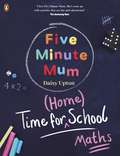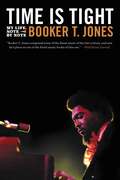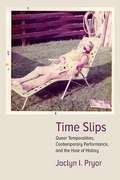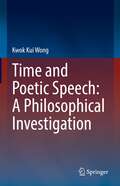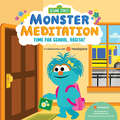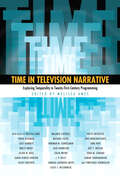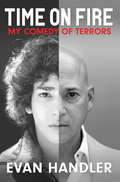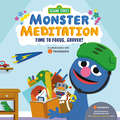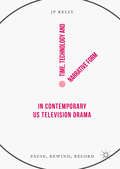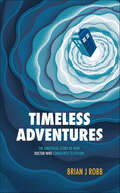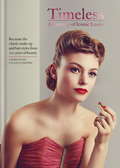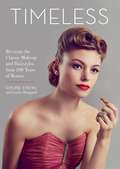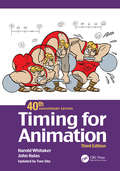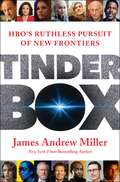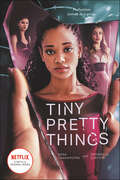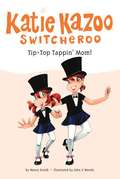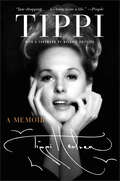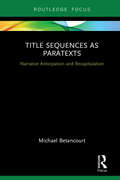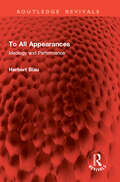- Table View
- List View
Time For Home School: Five minute fun games and activities to support early years and KS1 children with number sentences, counting and times tables
by Daisy UptonAn exclusive first look at Five Minute Mum: Time for School with the Maths chapter. It may not clear all those home school headaches, but it will make life easier- and a bit more fun too! The Maths chapter from Five Minute Mum: Time for School, is packed full of fun activities to immediately help support your child's maths learning including learning your number bonds, timetables and everything in between. Time for Home School: Maths is THE book you need if you're home-schooling, from former teaching assistant, bestselling author and social media superstar Daisy Upton AKA Five Minute Mum. This short chapter is all based around the maths your child will be taught in their first few years at school - Early Years, Reception and Key Stage 1 - will bring some much-needed laughter to your at-home learning and, if nothing else, give you five minutes where you feel like you are getting it right.Remember: 'IF YOU ARE TRYING, YOU ARE BRILLIANT' Daisy Upton brings her unique five-minute, learning-through-play method to these quick and easy, fun games and activities that are all maths based, using stuff you probably already have at home. Maths is taken from Five Minute Mum: Time for School- the ultimate handbook to support your child through Early Years, Reception and KS1 - available from 15 April 2021. Praise for Five Minute Mum: Give Me Five: 'I love Five Minute Mum. She's managed to come up with a huge array of activities for kids that are fun and educational yet don't require an Art degree or Diploma in Patience to execute. Her blog makes these kinds of games accessible to everyone and for that, I am grateful! - Sarah Turner, Unmumsy Mum 'So many fab ideas in here! Love it' - Rosie Ramsey
Time Is Tight: My Life, Note by Note
by Booker T. JonesThe long-awaited memoir of Booker T. Jones, leader of the famed Stax Records house band, architect of the Memphis soul sound, and one of the most legendary figures in music. From Booker T. Jones's earliest years in segregated Memphis, music was the driving force in his life. While he worked paper routes and played gigs in local nightclubs to pay for lessons and support his family, Jones, on the side, was also recording sessions in what became the famous Stax Studios-all while still in high school. Not long after, he would form the genre-defining group Booker T. and the MGs, whose recordings went on to sell millions of copies, win a place in Rolling Stone's list of top 500 songs of all time, and help forge collaborations with some of the era's most influential artists, including Otis Redding, Wilson Pickett, and Sam & Dave. Nearly five decades later, Jones's influence continues to help define the music industry, but only now is he ready to tell his remarkable life story. Time is Tight is the deeply moving account of how Jones balanced the brutality of the segregationist South with the loving support of his family and community, all while transforming a burgeoning studio into a musical mecca. Culminating with a definitive account into the inner workings of the Stax label, as well as a fascinating portrait of working with many of the era's most legendary performers-Bob Dylan, Willie Nelson, and Tom Jones, among them-this extraordinary memoir promises to become a landmark moment in the history of Southern Soul.
Time Out of Mind: The Lives of Bob Dylan
by Ian BellThe second volume in Ian Bell's magisterial two-part biography of the ever-evolving and enigmatic Bob Dylan By the middle of the 1970s, Bob Dylan's position as the pre-eminent artist of his generation was assured. The 1975 album Blood on the Tracks seemed to prove, finally, that an uncertain age had found its poet. Then Dylan faltered. His instincts, formerly unerring, deserted him. in the 1980s, what had once appeared unthinkable came to pass: the "voice of a generation" began to sound irrelevant, a tale told to grandchildren. Yet in the autumn of 1997, something remarkable happened. Having failed to release a single new song in seven long years, Dylan put out the equivalent of two albums in a single package. in the concluding volume of his ground- breaking study, ian Bell explores the unparalleled second act in a quintessentially american career. it is a tale of redemption, of an act of creative will against the odds, and of a writer who refused to fade away. Time Out of Mind is the story of the latest, perhaps the last, of the many Bob dylans.
Time Slips: Queer Temporalities, Contemporary Performance, and the Hole of History
by Jaclyn I. PryorPryor illuminates how each artist deploys performance as a tool to render history visible, trauma recognizable, and transformation possible by laying bare the histories and ongoing systems of violence woven deep into our society.
Time and Poetic Speech: A Philosophical Investigation
by Kwok Kui WongThis book analyzes the relation between the flow time and poetic speech in drama and rhetoric. It begins with the classical understanding of time as flux, and its problems and paradoxes entailing from Aristotle, Augustine, Kant and Husserl. The reader will see how these problems unfold and find resolutions through dramatic speech and rhetoric which has an essential relation to the flow of time. It covers elements in poetic speech such as affect, rhythm, metaphor, and syntax. It uses examples from classical rhetorical theories by Aristotle, Cicero, Quintilian, dramatic speeches from Shakespeare, as well as other modern dramatic texts by Chekhov, Beckett, Jelinek and Sarah Kane. This book appeals to students and academic researchers working in the philosophical fields of aesthetics and phenomenology as well those working in theater and the performing arts.
Time for School, Rosita!: Sesame Street Monster Meditation in collaboration with Headspace (Monster Meditation)
by Random HouseRosita learns a simple meditation called Belly Buddy Breathing to help calm her nerves before the first day of school—based on the popular Sesame Street Monster Meditation video on YouTube made in collaboration with the mindfulness app Headspace.Even monsters get nervous the first day of school! Luckily, Rosita learns a fun and easy way to calm her nerves! This terrific board book features Rosita learning a simple meditation that all young boys and girls can easily do whenever they feel nervous. This is Book 4 in a series of 6 books, all inspired by the popular Sesame Street Monster Meditation videos on YouTube, that will help young children learn mindfulness techniques along with their favorite characters. The videos are made in collaboration with Headspace, the mindfulness app. The art style in the books is the same as in the videos--bright and simple, to appeal to the youngest Sesame Street fans. Plus, there's an offer in the book for a free month of the Headspace app!Sesame Workshop, the nonprofit educational organization behind Sesame Street, aims to help kids grow smarter, stronger, and kinder through its many unique domestic and international initiatives. These projects cover a wide array of topics for families around the world.
Time in Television Narrative: Exploring Temporality in Twenty-First Century Programming
by Melissa AmesThis collection analyzes twenty-first-century American television programs that employ temporal and narrative experimentation. These shows play with time, slowing it down to unfold narrative through time retardation and compression. They disrupt the chronological flow of time itself, using flashbacks and insisting that viewers be able to situate themselves in both the present and the past narrative threads. Although temporal play has existed on the small screen prior to the new millennium, never before has narrative time been so freely adapted in mainstream television. The essayists offer explanations for not only the frequency of time-play in contemporary programming, but also the implications of its sometimes disorienting presence.Drawing upon the fields of cultural studies, television scholarship, and literary studies, as well as overarching theories concerning postmodernity and narratology, Time in Television Narrative offers some critical suggestions. The increasing number of television programs concerned with time may stem from any and all of the following: recent scientific approaches to quantum physics and temporality; new conceptions of history and post history; or trends in late-capitalistic production and consumption, in the new culture of instantaneity, or in the recent trauma culture amplified after the September 11 attacks. In short, these televisual time experiments may very well be an aesthetic response to the climate from which they derive. These essays analyze both ends of this continuum and also attend to another crucial variable: the television viewer watching this new temporal play.
Time on Fire
by Evan HandlerBased on Evan Handler's hit off-Broadway play (called by The New York Times "laceratingly funny and self-revealing"), Time on Fire is a remarkable memoir of illness and survival, love and hope-shot through with anger, humor, and piercing eloquence.Evan Handler was twenty-four and already an accomplished actor when he was diagnosed with acute leukemia and told that his chances for survival were slim. Resigning his role in Neil Simon's Biloxi Blues, Handler checked into New York Memorial's Cancer Center and began a bizarre, sometimes uproarious five-year journey in and out of hospitals-"a raucous rump through Hell"-only to face an equally arduous return to the life he left behind.Time on Fire is the story of Handler's passage into a twilight world: a place of lonely, haunting despair lit by moments of exultation and hilarity; a world where the truly horrible and the hysterically funny not only coexist but seem to become the same thing. Told with the trenchant humor of a survivor, it takes a wry, unflinching look at the absurdity of fighting for life in a place where death is what is most expected, and a health care system on the brink of madness. It is the story of refusing to succumb to the pressures of conformity that threatened his recovery and of the fierce struggle to find the road back to health-at all costs.From the comic accounts of his trip to a Madison Avenue sperm bank ("Nothing but the best address for my progeny") and his experimentation with psychic healing, to the portrayal of the unraveling effects of his illness on his family and girlfriend, Handler records with astonishing precision the full emotional range of his experience. The result is a bracing, achingly poignant account of his determination to steal time and reclaim life. Glowing with uncommon insights and uncompromising honesty, Time on Fire is a testament to the bravery and the endurance of the human spirit.
Time to Focus, Grover!: Sesame Street Monster Meditation in collaboration with Headspace (Monster Meditation)
by Random HouseGrover learns simple meditation techniques and plays a fun game to help him learn to focus on one thing at a time in this helpful board book—based on the popular Sesame Street Monster Meditation video on YouTube, made in collaboration with the mindfulness app Headspace.Sometimes everyone needs to slow down and take some cleansing belly breaths--even Grover! Grover is trying to do so many things at once that nothing's getting done! This terrific board book features Grover learning a game to help him focus and complete one task at a time. The game is a fun and simple one that all young children can easily learn and do whenever they feel overwhelmed. Plus there's an offer in the book for a free month of the Headspace app!This is book 3 in a series of six books, all inspired by the popular Sesame Street Monster Meditation videos on YouTube, that will help young girls and boys learn mindfulness techniques along with their favorite characters. The videos are made in collaboration with Headspace, the mindfulness app. The art style in the books is the same as in the videos--bright and simple, to appeal to the youngest Sesame Street fans. Look for Sesame Street: Monster Meditation books 1 and 2:Being Patient with Cookie MonsterGetting Ready for Bed with ElmoSesame Workshop, the nonprofit educational organization behind Sesame Street, aims to help kids grow smarter, stronger, and kinder through its many unique domestic and international initiatives. These projects cover a wide array of topics for families around the world.
Time, Technology and Narrative Form in Contemporary US Television Drama: Pause, Rewind, Record
by Jp KellyThis book examines how television has been transformed over the past twenty years by the introduction of new viewing technologies including DVDs, DVRs and streaming services such as Netflix, Hulu and Amazon Prime. It shows that these platforms have profoundly altered the ways we access and watch television, enabling viewers to pause, rewind, record and archive the once irreversible flow of broadcast TV. JP Kelly argues that changes in the technological landscape of television has encouraged the production of narrative forms that both explore and embody new industrial temporalities. Focusing on US television but also considering the role of TV within a global marketplace, the author identifies three distinct narrative temporalities: “acceleration” (24; Prison Break), “complexity” (Lost; FlashForward), and “retrospection” (Mad Men). Through industrial-textual analysis of television shows, this cross-disciplinary study locates these narrative temporalities in their socio-cultural contexts and examines connections between production, distribution, and narrative form in the contemporary television industry.
Timeless Adventures: The Unofficial Story of How Doctor Who Conquered Television
by Brian J. RobbThis critical history of Doctor Who covers the series 60 years, from the creation of the show to its triumph as Britain's number one TV drama. Opening with an in-depth account of the creation of the series within the BBC of the early 1960s, each decade of the show is tackled through a unique political and pop cultural historical viewpoint, exploring the links between contemporary Britain and the stories Doctor Who told, and how such links kept the show popular with a mass television audience. Timeless Adventures reveals how Doctor Who is at its strongest when it reflects the political and cultural concerns of a mass British audience (the 1960s, 1970s and 21st Century), and at its weakest when catering to a narrow fan-based audience (as in the 1980s). The book also addresses the cancellation of the show in the late 1980s (following the series becoming increasing self-obsessed) and the ways in which a narrowly-focused dedicated fandom contributed to the show's demise and yet was also instrumental in its regeneration for the 21st Century under Russell T. Davies, and analyses the new series to reveal what has made it so popular, reflecting real world issues like consumerism and dieting.
Timeless: A Century of Iconic Looks
by Louise Young Loulia SheppardBy Louise Young and Loulia Sheppard, 2018 Academy Award nominee for her hair and make-up design on Victoria and Abdul.'If you haven't heard of Louise Young and are interested in period makeup, or any makeup in fact, then we highly recommend you check out her latest book.' - PIXIWOOThe definitive step-by-step guide to recreating the most striking make-up and hair styles of the 20th century.Timeless is a beauty bible for the golden ages of style from renowned film, television and make-up artist Louise Young, along with Academy Award-nominated film industry hairstylist Loulia Sheppard.Step-by-step photography and clear, concise instructions help you to recreate make-up and hair looks from the past 100 years of beauty, from the dark, smouldering eyes of the jazz-age flapper to the red lips and victory rolls of the 1940s, right up to the electric colours of the 1980s and beyond.Accurate, practical and beautiful, this is the ultimate guide to the most classic looks of all time.Between them, Louise and Loulia have provided make-up and hair styling for stars such as Scarlett Johansson, Keira Knightley and Selma Hayek, and on films including Victoria and Abdul, Fantastic Beasts and Where to Find Them, Pride and Prejudice, Florence Foster Jenkins, Anna Karenina and The Duchess, among many others.
Timeless: Recreate the Classic Makeup and Hairstyles from 100 Years of Beauty
by Louise Young Loulia SheppardFrom renowned film, TV, and fashion makeup artist Louise Young-along with leading film industry hairstylist Loulia Sheppard, Timeless is the definitive step-by-step guide to the most iconic looks of a century.Timeless is a beauty bible for the golden ages of style. Step-by-step photography and clear, concise instructions help you to recreate the most memorable makeup and hair looks of the past 100 years, including: The silent-screen "vamp" Jazz-Age bob and smoldering eyes 1930s Hollywood glamour World War II-era red lips and victory rolls The 1950s bombshell Swinging '60s London Look Disco-fever beauty The colorful, eclectic '80s Grunge-era chicThroughout, Timeless provides inspiration and instruction on how to recreate the looks of beauty icons like Louise Brooks, Clara Bow, Ginger Rogers, Myrna Loy, Betty Grable, Rita Hayworth, Ava Gardner, Lauren Bacall, Gene Tierney, Grace Kelly, Lucille Ball, Elizabeth Taylor, Marilyn Monroe, Audrey Hepburn, Jean Shrimpton, Sophia Loren, Farrah Fawcett, Julia Roberts, Brooke Shields, Kate Moss, Drew Barrymore, and many more.Accurate, practical, and beautiful, this is the ultimate guide to the most classic looks of all time-a must-have for makeup artists, hairstylists, classic film fans, and anyone interested in incorporating vintage style into the modern day.
Timing for Animation, 40th Anniversary Edition
by Harold Whitaker John HalasTiming for Animation has been one of the pillars of animation since it was first published in 1981. Now this 40th anniversary edition captures the focus of the original and enhances this new edition with fresh images, techniques, and advice from world-renowned animators. Not only does the text explore timing in traditional animation, but also timing in digital works. Vibrant illustrations and clear directions line the pages to help depict the various methods and procedures to bring your animation to life. Examples include timing for digital production, digital storyboarding in 2D, digital storyboarding in 3D, and the use of After Effects, as well as interactive games, television, animals, and more. Learn how animated scenes should be arranged in relation to each other, how much space should be used, and how long each drawing should be shown for maximum dramatic effect. All you need to breathe life into your animation is at your fingertips with Timing for Animation. Key Features: Fully revised and updated with modern examples and techniques Explores the fundamentals of timing, physics, and animation Perfect for the animation novice and the expert Get straight to the good stuff with simple, no-nonsense instruction on the key techniques like stretch and squash, animated cycles, overlapping, and anticipation. Trying to time weight, mood, and power can make or break an animation—get it right the first time with these tried and tested techniques. Authors Harold Whitaker was a BAFTA-nominated professional animator and educator for 40 years; many of his students number among today’s most outstanding animation artists. John Halas, known as "The father of British animation" and formerly of Halas & Batchelor Animation Studio, produced more than 2,000 animation films, including the legendary Animal Farm (1954) and the award-winning Dilemma (1981). He was also the founder and president of the International Animated Film Association (ASIFA) and former Chairman of the British Federation of Film Societies. Tom Sito is Professor of Animation at the University of Southern California and has written numerous books and articles on animation. Tom’s screen credits include Shrek (2001) and the Disney classics Who Framed Roger Rabbit (1988), The Little Mermaid (1989), Beauty and the Beast (1991), Aladdin (1992), and The Lion King (1994). In 1998, Tom was named by Animation Magazine as one of the 100 Most Important People in Animation.
Timmy's in the Well: The Jon Provost Story
by Jon Provost Laurie JacobsonIn this memoir Jon Provost describes his experiences as a child superstar and shares celebrity anecdotes. Timmy's in the Well illustrates what happens to a middle-class American family touched by fame. Jon's first job came at age three, forever altering the course of his life and the lives of his family. With nearly a dozen film appearances in a mere five years, Provost was named the top child movie actor of 1958 by the New York Film Critics. Yet he could barely read, hardly knew his siblings, and had few friends under the age of 35. More than 200 interviews add texture and humor to this thoroughly researched story, and the book includes a vivid portrait of the inner workings of Hollywood of the 1950s and 1960s, and it is populated with some of the biggest names of the day. [All spelling, grammatical and punctuation errors are errors that are in the book itself, not the scan.]
Tinderbox: HBO's Ruthless Pursuit of New Frontiers
by James Andrew MillerTinderbox tells the exclusive, explosive, uninhibited true story of HBO and how it burst onto the American scene and screen to detonate a revolution and transform our relationship with television forever. The Sopranos, Game of Thrones, Sex and the City, The Wire, Succession…HBO has long been the home of epic shows, as well as the source for brilliant new movies, news-making documentaries, and controversial sports journalism. By thinking big, trashing tired formulas, and killing off cliches long past their primes, HBO shook off the shackles of convention and led the way to a bolder world of content, opening the door to all that was new, original, and worthy of our attention. In Tinderbox, award-winning journalist James Andrew Miller uncovers a bottomless trove of secrets and surprises, revealing new conflicts, insights, and analysis. As he did to great acclaim with SNL in Live from New York; with ESPN in Those Guys Have All the Fun; and with talent agency CAA in Powerhouse, Miller continues his record of extraordinary access to the most important voices, this time speaking with talents ranging from Abrams (J. J.) to Zendaya, as well as every single living president of HBO—and hundreds of other major players.Over the course of more than 750 interviews with key sources, Miller reveals how fraught HBO’s journey has been, capturing the drama and the comedy off-camera and inside boardrooms as HBO created and mobilized a daring new content universe, and, in doing so, reshaped storytelling and upended our entertainment lives forever.
Tinseltown: Murder, Morphine, and Madness at the Dawn of Hollywood
by William J. MannNew York Times Bestseller • Edgar Award winner for Best Fact CrimeThe Day of the Locust meets The Devil in the White City and Midnight in the Garden of Good and Evil in this juicy, untold Hollywood story: an addictive true tale of ambition, scandal, intrigue, murder, and the creation of the modern film industry.By 1920, the movies had suddenly become America’s new favorite pastime, and one of the nation’s largest industries. Never before had a medium possessed such power to influence. Yet Hollywood’s glittering ascendency was threatened by a string of headline-grabbing tragedies—including the murder of William Desmond Taylor, the popular president of the Motion Picture Directors Association, a legendary crime that has remained unsolved until now.In a fiendishly involving narrative, bestselling Hollywood chronicler William J. Mann draws on a rich host of sources, including recently released FBI files, to unpack the story of the enigmatic Taylor and the diverse cast that surrounded him—including three beautiful, ambitious actresses; a grasping stage mother; a devoted valet; and a gang of two-bit thugs, any of whom might have fired the fatal bullet. And overseeing this entire landscape of intrigue was Adolph Zukor, the brilliant and ruthless founder of Paramount, locked in a struggle for control of the industry and desperate to conceal the truth about the crime. Along the way, Mann brings to life Los Angeles in the Roaring Twenties: a sparkling yet schizophrenic town filled with party girls, drug dealers, religious zealots, newly-minted legends and starlets already past their prime—a dangerous place where the powerful could still run afoul of the desperate.A true story recreated with the suspense of a novel, Tinseltown is the work of a storyteller at the peak of his powers—and the solution to a crime that has stumped detectives and historians for nearly a century.
Tiny Pretty Things (Tiny Pretty Things #1)
by Sona Charaipotra Dhonielle ClaytonNow a Netflix TV show! Black Swan meets Pretty Little Liars in this soapy, drama-packed novel featuring diverse characters who will do anything to be the prima at their elite ballet school.From the New York Times-bestselling author of The Belles, Dhonielle Clayton, and the author of the acclaimed Symptoms of a Heartbreak, Sona Charaipotra.Gigi, Bette, and June, three top students at an exclusive Manhattan ballet school, have seen their fair share of drama. Free-spirited new girl Gigi just wants to dance—but the very act might kill her. Privileged New Yorker Bette's desire to escape the shadow of her ballet-star sister brings out a dangerous edge in her. And perfectionist June needs to land a lead role this year or her controlling mother will put an end to her dancing dreams forever.When every dancer is both friend and foe, the girls will sacrifice, manipulate, and backstab to be the best of the best.Don’t miss the gossip, lies, and scandal that continues in Tiny Pretty Things’ gripping sequel, Shiny Broken Pieces!
Tip-Top Tappin' Mom! (Katie Kazoo Switcheroo #31)
by Nancy KrulikKatie is giving her mom tap dancing lessons! Mrs. Carew really loves Katie. But when the magic wind switcheroos Katie into her mom right before the audition, Katie panics and blows the audition.
Tippi: A Memoir
by Tippi HedrenIn this absorbing and surprising memoir, one of the biggest names of classic Hollywood—the star of Alfred Hitchcock’s The Birds and Marnie—tells her story, including never-before-revealed experiences on the set of some of the biggest cult films of all time . . . now with a foreword by Melanie GriffithFor decades, Tippi Hedren’s luminous beauty radiated from the silver screen, enchanting moviegoers and cementing her position among Hollywood’s elite—beauty and star power that continue to endure. For too long Hedren’s story has been told by others through whispered gossip and tabloid headlines. Now, Hedren sets the record straight, recalling how a young and virtuous Lutheran girl from small-town Minnesota became a worldwide legend—as one of the most famous Hitchcock girls, as an unwavering animal activist, and as the matriarch of a powerful Hollywood dynasty that includes her movie star daughter Melanie Griffith, and rising star Dakota Johnson, her granddaughter.For the first time, Hedren digs deep into her complicated relationship with the man who discovered her talent, director Alfred Hitchcock, the benefactor who would become a repulsive and controlling director who contractually controlled her every move. She speaks openly about the dark pain she endured working with him on their most famous collaborations, The Birds and Marnie, and finding the courage she needed to break away.Hedren’s incandescent spirit shines through as she talks about working with the great Charlie Chaplin, sharing the screen with some of the most esteemed actors in Hollywood, her experiences on some of the most intriguing and troubling film sets—including filming Roar, one of the most dangerous movies ever made—and the struggles of being a single mother—balancing her dedication to her work and her devotion to her daughter—and her commitment to helping animals. Filled with sixteen pages of beautiful photos, Tippi is a rare and fascinating look at a private woman’s remarkable life no celebrity aficionado can miss.
Tips: Ideas for Actors
by Jon JoryUntil very recently, acting was passed on the form of "tips". Here are 205 of them -- ranging from using opposites to the way to set a laugh, and on through a clear definition of "actions", how to use a "breath score", and even how to react if you're fired. The tips are clear, concise, evocative and constructed to give you a better day in rehearsal and a better night in performance. A buffet of ways to improve immediately that you'll want to have with you in your rehearsal bag.
Tissues, Cultures, Art (Palgrave BioArt)
by Ionat Zurr Oron CattsTissues, Cultures, Art narrates the twenty-five years of collaborative and sometimes provocative artistic practice and scholarly thought of Catts & Zurr, who pioneered the use of regenerative biology techniques to create Semi-Living art using living cells, tissues, and technological surrogate bodies. Through hands-on work in biological laboratories, the authors researched concepts such as partial-life and DNA-Chauvinism and explored the fantasies of living in a technologically mediated victimless utopia. The authors delve into life’s resistance to reductionism, systemisation and control, asking whether there is something unique to life without the need to resort to metaphysics. Their practices reach beyond the confines of art and are often cited as precursors to the cellular agriculture and biofabrication industries. Through a hybrid of personal reflections, poetics, and anecdotes with a more rigorous, scholarly approach – all illustrated with artworks - the authors present a critical view on the use of life as a raw material for human manipulation.
Title Sequences as Paratexts: Narrative Anticipation and Recapitulation
by Michael BetancourtIn his third book on the semiotics of title sequences, Title Sequences as Paratexts, theorist Michael Betancourt offers an analysis of the relationship between the title sequence and its primary text—the narrative whose production the titles credit. Using a wealth of examples drawn from across film history—ranging from White Zombie (1931), Citizen Kane (1940) and Bullitt (1968) to Prince of Darkness (1987), Mission: Impossible (1996), Sucker Punch (2011) and Guardians of the Galaxy, Vol. 2 (2017)—Betancourt develops an understanding of how the audience interprets title sequences as instances of paranarrative, simultaneously engaging them as both narrative exposition and as credits for the production. This theory of cinematic paratexts, while focused on the title sequence, has application to trailers, commercials, and other media as well.
Title and Deed / Oh, the Humanity and other good intentions
by Will Eno"A haunting and often fiercely funny meditation on life as a state of permanent exile... The marvel of Mr. Eno's voice is how naturally it combines a carefully sculptured lyricism with sly, poker-faced humor. Everyday phrases and familiar platitudes-'Don't ever change,' 'Who knows'-are turned inside out or twisted into blunt, unexpected punch lines punctuating long rhapsodic passages that leave you happily word-drunk." -Charles Isherwood, New York Times on Title and Deed"Title and Deed is daring within its masquerade of the mundane, spectacular within its minimalism and hilarious within its display of po-faced bewilderment. It is a clown play that capers at the edge of the abyss... Eno's voice is unique; his play is stage poetry of a high order. You can't see the ideas coming in Title and Deed. When they arrive-tiptoeing in with a quiet yet startling energy-you don't quite know how they got there. In this tale's brilliant telling, it is not the narrator who proves unreliable but life itself. The unspoken message of Eno's smart, bleak musings seems to be: enjoy the nothingness while you can." -John Lahr, New Yorker"Eno is a supreme monologist, using a distinctive, edgy blend of non sequiturs and provisional statements to explore the fragility of our existence... There are a lot of words, but they are always exquisitely chosen... Oh, the Humanity reveals that we are beautiful walking tragedies blinking with absurd optimism into the camera lens of history." -Lyn Gardner, GuardianKnown for his wry humor and deeply moving plays, Will Eno's "gift for articulating life's absurd beauty and its no less absurd horrors may be unmatched among writers of his generation" (New York Times). This new volume of the acclaimed playwright's work includes five short plays about being alive-Behold the Coach, in a Blazer, Uninsured; Ladies and Gentlemen, the Rain; Enter the Spokeswoman, Gently; The Bully Composition; and Oh, the Humanity-as well as Title and Deed, a haunting and severely funny solo rumination on life as everlasting exile.WILL ENO is a fellow of Residency Five at Signature Theatre Company in New York. His play The Open House premiered at Signature in 2014, and received an Obie Award, the Lucille Lortel Award for Best Play, and a Drama Desk Special Award. His play The Realistic Joneses premiered at Yale Repertory Theatre in 2012, and was produced on Broadway in 2014, for which he and the cast received a Drama Desk Special Award. His play Title and Deed premiered at Signature in 2012 and was presented at the Edinburgh Fringe Festival in 2014. Both Title and Deed and The Realistic Joneses were included in the New York Times Best Plays List of 2012. Gnit, an adaption of Ibsen's Peer Gynt, premiered at Actors Theatre of Louisville in 2013. Middletown, winner of the Horton Foote Prize, premiered at the Vineyard Theatre in New York in 2010, and was then produced at Steppenwolf Theatre Company in Chicago in 2011. Thom Pain (based on nothing) was a finalist for the 2005 Pulitzer Prize and has been translated into many languages. The Flu Season premiered at the Gate Theatre in London in 2003, and later received the Oppenheimer Award for best New York debut production by an American writer. Tragedy: a tragedy premiered at the Gate Theatre in 2001, and was subsequently produced by Berkeley Repertory Theatre in 2008. Mr. Eno lives in Brooklyn with his wife Maria Dizzia and their daughter Albertine.
To All Appearances: Ideology and Performance (Routledge Revivals)
by Herbert BlauFirst published in 1992, To All Appearances is a book in which ideology and performance shadow each other, in a theoretical inquiry which ranges widely across historical periods and cultures. The author’s concerns—which include the social meaning of illusion and the cultural manifestation of power—take the reader from Jacobean drama to the pageantry of Robert Wilson; from Eleanora Duse to Laurie Anderson; from the puppet theater of Kleist to Kantor’s theater of the dead; and from the Kutiyattam temple dancers in Kerala to Womanhouse in Los Angeles.A brilliant, uncontainable, and chastening look at the rhetoric of critical theory in relation to performance and ideological practice, this is undoubtedly a book for the twenty-first century. It returns us, through all appearances, to the unavoidable question in art, in politics, in the society of the spectacle: what, after all, is the future of illusion?
